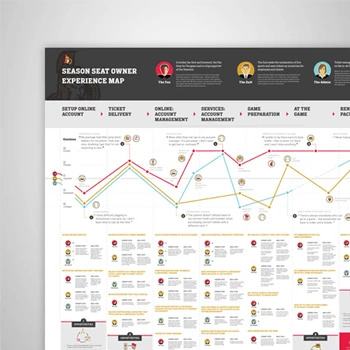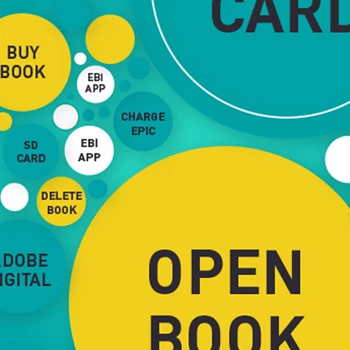What is digital transformation and how does it differ from digitization?
Digital transformation is the fundamental reimagining of how organizations deliver value through technology-enabled experiences, while digitization simply converts analog processes to digital. Our approach focuses on creating organizational cultures anchored in delivering excellent customer and user experiences through the strategic integration of people, business models, processes, and technology.
Tip: Start by defining what transformation success looks like for your customers and users rather than focusing on technology adoption metrics to ensure efforts create real value.
How does Experience Thinking apply to digital transformation?
Experience Thinking provides the framework for human-centered digital transformation by ensuring technology implementations improve actual customer and employee experiences. We align the four structural elements—people, business, process, and technology—to deliver connected experiences across brand, content, product, and service touchpoints.
Tip: Use Experience Thinking to evaluate every transformation initiative against its impact on end-user experiences rather than internal operational metrics alone.
What are the key components of successful digital transformation?
Successful transformation requires alignment across four areas: people (competencies and culture), business models (value creation and delivery), processes (workflows and methodologies), and technology (enabling tools and platforms). All four must work together to create and sustain improved experiences for customers, users, and employees.
Tip: Assess your current maturity in all four areas before beginning transformation initiatives to identify where foundational work is needed most urgently.
Why do many digital transformation initiatives fail?
Most failures occur because organizations focus primarily on technology adoption rather than experience improvement, underinvest in change management and culture development, lack clear success metrics, or try to transform everything simultaneously. Successful transformation requires deliberate action, planned communication, training, and ongoing monitoring.
Tip: Plan for transformation to take 2-3 years of sustained effort to see real cultural change rather than expecting quick wins to create lasting organizational transformation.
How do you approach digital transformation for different industry sectors?
While the Experience Thinking framework remains consistent, industry applications vary based on regulatory requirements, customer expectations, competitive dynamics, and technology maturity. We adapt our approach for sectors including technology, energy, media, healthcare, and financial services while maintaining focus on human-centered outcomes.
Tip: Understand your industry's specific transformation challenges and opportunities early in the planning process to avoid generic approaches that miss sector-specific value creation opportunities.
What role does organizational culture play in digital transformation?
Culture is foundational to transformation success because technology and processes only deliver value when people embrace and effectively use them. We help organizations develop experience-centered cultures that prioritize customer and user needs, encourage experimentation, and support continuous learning and adaptation.
Tip: Invest significantly in culture change initiatives from the beginning rather than treating them as afterthoughts, as cultural resistance is the primary reason transformation efforts stall or fail.
How do you measure digital transformation success?
Transformation success is measured through experience metrics (customer satisfaction, user engagement), business outcomes (revenue growth, operational efficiency), and organizational indicators (employee adoption, cultural change). We establish baseline measurements and track progress across multiple dimensions to ensure transformation delivers intended value.
Tip: Define success metrics that connect transformation activities to business outcomes and customer value rather than focusing solely on technology adoption or process completion rates.
How do you develop a digital transformation strategy?
Our strategy development process includes innovation discovery, stakeholder analysis, competitive landscape assessment, customer and user journey mapping, organizational capability assessment, and roadmap creation. We ensure transformation strategies align with business goals while prioritizing human-centered experience improvements.
Tip: Begin strategy development with deep customer and user research to understand current experience gaps before defining technology solutions or process changes.
What's your approach to innovation strategy within digital transformation?
Innovation strategy focuses on identifying market opportunities, understanding competitive positioning, and creating differentiated customer experiences through strategic technology application. We help organizations balance incremental improvements with breakthrough innovation while managing risk and resource allocation effectively.
Tip: Dedicate specific resources and governance processes to innovation initiatives rather than expecting transformation teams to handle both operational improvement and breakthrough innovation simultaneously.
How do you prioritize transformation initiatives across the organization?
Prioritization considers customer impact, business value, implementation complexity, resource requirements, and organizational readiness. We create roadmaps that balance quick wins for momentum with foundational changes needed for long-term success, ensuring each initiative builds toward the overall transformation vision.
Tip: Start with initiatives that improve customer experiences in highly visible ways to build organizational confidence and support for more complex transformation work.
What role does competitive analysis play in transformation strategy?
Competitive analysis reveals market opportunities, identifies best practices, and helps organizations understand customer expectations shaped by other industry experiences. We analyze both direct competitors and companies from adjacent industries to identify transformation opportunities and differentiation strategies.
Tip: Study transformation approaches from leading companies outside your industry to identify innovative approaches that could create competitive advantages in your market.
How do you align transformation strategy with existing business strategy?
Transformation strategy must reinforce and enable broader business strategy rather than operating independently. We ensure transformation initiatives support strategic business goals, enhance competitive positioning, and create sustainable organizational capabilities that drive long-term value creation.
Tip: Involve senior leadership in transformation strategy development to ensure alignment with business priorities and secure necessary resources and organizational commitment.
What's your approach to stakeholder engagement in transformation planning?
Stakeholder engagement includes collaborative workshops, individual interviews, cross-functional working groups, and regular communication sessions. We ensure all stakeholder perspectives are considered while building consensus around transformation vision, priorities, and implementation approaches.
Tip: Include frontline employees and customers in strategy development sessions to ensure transformation plans address real operational challenges and customer needs.
How do you create transformation roadmaps that remain flexible?
Flexible roadmaps balance strategic direction with adaptation capability through modular initiative design, regular review cycles, success criteria monitoring, and scenario planning. We create frameworks that enable course correction while maintaining momentum toward transformation goals.
Tip: Build roadmap review and adjustment processes into your governance structure rather than treating roadmaps as fixed plans that can't evolve with changing business conditions.
What change management approaches do you use for transformation?
Our change management integrates Experience Thinking principles with proven organizational development methods including stakeholder analysis, communication planning, training programs, culture assessment, and continuous feedback mechanisms. We focus on building experience-centered mindsets and capabilities throughout the organization.
Tip: Treat change management as a core transformation capability rather than a support function to ensure cultural change receives appropriate attention and resources throughout the transformation journey.
How do you build organizational capability for sustained transformation?
Capability building includes establishing internal expertise in experience design, creating cross-functional collaboration processes, developing measurement systems, and building continuous improvement cultures. We transfer knowledge and methods to ensure organizations can continue evolving independently.
Tip: Identify and develop internal transformation champions who can sustain change efforts and guide future initiatives rather than relying solely on external consulting support.
What's your approach to leadership development during transformation?
Leadership development focuses on building experience-centered thinking, change leadership skills, cross-functional collaboration abilities, and digital fluency. We work with senior leaders to model transformation behaviors and create organizational conditions that support sustained change.
Tip: Invest in developing leaders' ability to communicate transformation vision and progress in language that resonates with different organizational functions and levels.
How do you handle resistance to transformation initiatives?
Resistance management involves understanding underlying concerns, addressing legitimate obstacles, involving skeptics in solution development, demonstrating early wins, and providing adequate support for skill development. We treat resistance as valuable feedback that can improve transformation approaches.
Tip: Address resistance through involvement and education rather than mandates, as people who understand the reasoning behind changes are more likely to become transformation advocates.
What training and development programs support transformation?
Training programs include experience design methods, digital collaboration tools, customer research techniques, agile working approaches, and cross-functional communication skills. We customize programs based on organizational needs and individual role requirements while building practical application opportunities.
Tip: Combine formal training with on-the-job application and peer learning opportunities to ensure new skills and knowledge transfer into daily work practices.
How do you maintain transformation momentum over time?
Momentum maintenance requires celebrating milestones, communicating progress regularly, adjusting approaches based on feedback, providing ongoing support, and connecting transformation activities to business results. We establish rhythms and rituals that reinforce transformation behaviors.
Tip: Create regular opportunities for people to share transformation successes and lessons learned to build organizational learning and maintain engagement throughout the journey.
What governance structures support successful transformation?
Effective governance includes transformation steering committees, cross-functional working groups, regular review processes, decision-making frameworks, and communication protocols. We establish structures that enable coordination while empowering teams to act quickly on transformation opportunities.
Tip: Design governance structures that facilitate decision-making and remove barriers rather than creating additional bureaucracy that slows transformation progress.
How do you approach technology selection for transformation initiatives?
Technology selection prioritizes user experience requirements, integration capabilities, scalability potential, and organizational change readiness rather than feature lists or vendor relationships. We ensure technology choices support experience goals while considering implementation complexity and change management requirements.
Tip: Involve end users in technology evaluation processes to ensure selected solutions will actually improve their work experience and productivity rather than creating additional complexity.
What's your approach to legacy system integration during transformation?
Legacy integration balances immediate experience improvements with long-term architecture evolution. We design integration approaches that improve user experiences while creating migration paths toward more modern architectures, avoiding the need for complete system replacement before transformation can begin.
Tip: Focus integration efforts on improving user-facing experiences first rather than trying to modernize entire backend systems before delivering any customer value.
How do you ensure technology implementations support rather than hinder user experiences?
User-centered technology implementation includes experience requirements definition, user journey mapping, usability testing throughout development, change management support, and post-implementation optimization. We ensure technology serves human needs rather than forcing people to adapt to system limitations.
Tip: Establish user experience criteria as acceptance requirements for technology implementations rather than treating usability as a nice-to-have feature that can be addressed later.
What role does data and analytics play in transformation initiatives?
Data and analytics provide insights into current experience performance, identify improvement opportunities, measure transformation progress, and enable continuous optimization. We help organizations build data capabilities that support evidence-based experience design and transformation decision-making.
Tip: Invest in data literacy across the organization rather than centralizing analytics capabilities, as widespread data understanding enables better transformation decisions at all levels.
How do you handle cybersecurity and privacy considerations in transformation?
Security and privacy are integrated into transformation planning from the beginning through risk assessment, compliance requirements analysis, security architecture design, and user education programs. We ensure transformation initiatives enhance rather than compromise organizational security posture.
Tip: Include security and privacy teams in transformation planning early to avoid costly retrofitting and ensure new capabilities meet compliance requirements from launch.
What's your approach to cloud migration and infrastructure transformation?
Infrastructure transformation focuses on enabling better user experiences, improving operational efficiency, and creating scalability for future growth rather than simply moving existing systems to cloud platforms. We align infrastructure decisions with experience goals and business strategy.
Tip: Plan infrastructure transformation to support experience improvements and business capabilities rather than treating it as a separate technical initiative disconnected from user value creation.
How do you address technology vendor management during transformation?
Vendor management includes experience-focused procurement criteria, implementation support requirements, ongoing relationship management, and performance measurement aligned with transformation goals. We help organizations build vendor relationships that support rather than complicate transformation efforts.
Tip: Establish vendor performance metrics that include user experience outcomes rather than only technical specifications to ensure external partners contribute to transformation success.
How does digital transformation improve customer experience?
Transformation improves customer experience through connected journey design, reduced friction across touchpoints, personalized interactions, faster issue resolution, and consistent service delivery. We ensure transformation initiatives directly enhance how customers interact with and benefit from your organization.
Tip: Map current customer journeys to identify specific pain points and friction areas before designing transformation solutions to ensure efforts address real customer problems.
What's your approach to customer journey transformation?
Journey transformation involves current state mapping, future state design, gap analysis, touchpoint optimization, and cross-channel integration. We redesign customer journeys to be more intuitive, efficient, and valuable while supporting business goals and operational constraints.
Tip: Include customers in journey redesign processes through research and testing rather than relying solely on internal assumptions about what customers want or need.
How do you ensure transformation initiatives address real customer needs?
Customer need validation includes ethnographic research, journey shadowing, interview programs, feedback analysis, and continuous testing throughout transformation implementation. We ensure transformation efforts solve actual customer problems rather than internal operational preferences.
Tip: Establish regular customer research rhythms throughout transformation rather than conducting research only at the beginning to ensure initiatives remain aligned with evolving customer needs.
What role does personalization play in digital transformation?
Personalization enables more relevant, efficient, and valuable customer experiences through data-driven customization, predictive service delivery, and adaptive interfaces. We balance personalization benefits with privacy concerns and implementation complexity to create appropriate solutions.
Tip: Start with simple personalization approaches that provide clear customer value before investing in complex algorithmic personalization to build trust and demonstrate benefits.
How do you measure customer experience improvements from transformation?
Customer experience measurement includes satisfaction scores, journey completion rates, effort scores, loyalty metrics, and behavioral indicators. We establish baseline measurements and track improvements throughout transformation to demonstrate value and identify optimization opportunities.
Tip: Use multiple measurement approaches including quantitative metrics and qualitative feedback to get complete understanding of customer experience improvements rather than relying on single metrics.
What's your approach to omnichannel experience design in transformation?
Omnichannel design creates consistent, connected experiences across all customer touchpoints through unified design systems, integrated data platforms, coordinated service delivery, and seamless channel transitions. We ensure customers receive coherent experiences regardless of how they interact with your organization.
Tip: Design for channel transitions and handoffs rather than optimizing individual channels in isolation to create truly seamless omnichannel customer experiences.
How do you handle customer communication during major transformation initiatives?
Customer communication includes change notifications, benefit explanations, support resources, feedback collection mechanisms, and progress updates. We ensure customers understand how transformation improvements will benefit them while providing support during transition periods.
Tip: Communicate transformation benefits in customer language focused on how changes will improve their experience rather than internal process improvements or technology capabilities.
How does digital transformation impact employee experience?
Transformation should improve employee experience through better tools, streamlined processes, clearer role definition, enhanced collaboration capabilities, and reduced administrative burden. We ensure transformation initiatives support employee productivity and job satisfaction while achieving business goals.
Tip: Include employee experience metrics in transformation success criteria to ensure internal stakeholders benefit from changes and remain engaged throughout the transformation journey.
What's your approach to employee engagement during transformation?
Employee engagement includes participatory design sessions, regular feedback collection, transparent communication, skill development opportunities, and recognition programs. We involve employees in shaping transformation rather than imposing changes without their input and collaboration.
Tip: Create employee advisory groups for major transformation initiatives to ensure worker perspectives inform decisions and build ownership for transformation outcomes.
How do you address job role changes and skill development needs?
Role evolution support includes skills gap analysis, training program development, career path planning, mentoring systems, and transition support. We help employees adapt to changing role requirements while building capabilities needed for future organizational success.
Tip: Invest in comprehensive reskilling programs rather than assuming employees will naturally adapt to new role requirements, as skill development support demonstrates organizational commitment to employee success.
What's your approach to workplace culture transformation?
Culture transformation focuses on developing shared values, collaborative behaviors, experience-centered thinking, continuous learning attitudes, and change adaptability. We help organizations evolve cultures that support sustained transformation and ongoing innovation.
Tip: Define desired cultural behaviors specifically and create systems that reinforce those behaviors rather than relying on values statements alone to drive cultural change.
How do you ensure transformation doesn't negatively impact employee well-being?
Employee well-being protection includes change pace management, stress monitoring, support resource provision, workload balancing, and mental health considerations. We design transformation approaches that support rather than overwhelm employees while achieving necessary organizational changes.
Tip: Monitor employee stress and engagement levels throughout transformation and adjust pace or support levels when indicators suggest transformation is negatively impacting well-being.
What role does remote work play in digital transformation?
Remote work capabilities enable organizational flexibility, access to global talent, reduced operational costs, and improved work-life balance while requiring new collaboration tools, management approaches, and culture development. We help organizations optimize remote work as part of transformation.
Tip: Design remote work policies and tools that support collaboration and culture development rather than simply enabling people to work from different locations.
How do you build internal innovation capabilities through transformation?
Innovation capability building includes creative thinking training, experimentation processes, failure tolerance development, cross-functional collaboration, and idea management systems. We help organizations become more innovative while implementing current transformation initiatives.
Tip: Create safe-to-fail experimentation opportunities that allow employees to develop innovation skills while contributing to transformation goals rather than waiting until transformation is complete to focus on innovation.
How do you approach AI integration in digital transformation initiatives?
AI integration focuses on augmenting human capabilities rather than replacing human judgment through transparent AI behaviors, user control maintenance, clear value delivery, and ethical implementation. We ensure AI features enhance user experiences while building trust through explainable and controllable AI interactions that support rather than replace human decision-making.
Tip: Start AI integration with clear use cases that solve specific user problems rather than implementing AI technology for its own sake, ensuring adoption and demonstrable value creation.
What's your AI UX strategy approach for transformation projects?
AI UX strategy ensures AI products impact user experiences positively through human-centered design principles, user research validation, interaction design optimization, and continuous user feedback integration. We create AI experiences that are well-used and well-loved by focusing on user needs rather than technology capabilities.
Tip: Design AI interactions that provide clear user benefit and maintain user agency rather than creating 'black box' experiences that users can't understand or control.
How do you address AI ethics and bias in transformation initiatives?
AI ethics integration includes bias assessment, fairness monitoring, transparency requirements, accountability frameworks, and inclusive design practices. We ensure AI implementations support equitable outcomes and maintain user trust through responsible AI development and deployment practices.
Tip: Establish AI ethics review processes early in transformation planning rather than addressing ethical considerations after AI systems are already developed and deployed.
What role does AI play in improving customer service during transformation?
AI-enhanced customer service provides faster issue resolution, personalized support, predictive assistance, and seamless human handoffs while maintaining service quality and customer satisfaction. We design AI customer service that augments rather than replaces human support capabilities.
Tip: Implement AI customer service gradually with careful monitoring of customer satisfaction to ensure AI enhancements actually improve rather than degrade the customer support experience.
How do you handle data requirements for AI implementations in transformation?
AI data requirements include data quality assessment, privacy compliance, infrastructure planning, model training datasets, and ongoing data management. We ensure organizations have appropriate data foundations to support AI initiatives while maintaining security and privacy standards.
Tip: Audit your data quality and governance capabilities before planning AI implementations to ensure you have the foundation needed for successful AI deployment.
What's your approach to AI-powered automation in business processes?
AI automation focuses on improving process efficiency, reducing manual errors, enabling employee focus on higher-value work, and enhancing customer experiences through intelligent process optimization. We balance automation benefits with human oversight and intervention capabilities.
Tip: Start process automation with clear efficiency goals and employee impact assessment to ensure automation supports rather than displaces valuable human contributions.
How do you prepare organizations for future AI developments during transformation?
AI readiness preparation includes building data infrastructure, developing AI literacy, establishing ethical frameworks, creating experimentation capabilities, and fostering innovation cultures. We help organizations become AI-ready while focusing on current transformation priorities.
Tip: Build AI capabilities gradually through pilot projects and learning initiatives rather than waiting for perfect AI strategies before beginning any AI-related transformation work.












